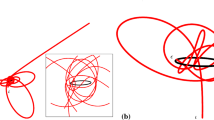Abstract
Penrose1 and Christodoulou2 have shown how, in principle, rotational energy can be extracted from a black hole by orbiting and fissioning particles. Recently, Misner3 has pointed out that waves can also extract rotational energy (“superradiant scattering” in which an impinging wave is amplified as it scatters off a rotating hole). As one application of super-radiant scattering, Misner has suggested the possible existence of “floating orbits”, that is, orbits in which a particle radiatively extracts energy from the hole at the same rate as it radiates energy to infinity; thereby it experiences zero net radiation reaction.
Similar content being viewed by others
References
Penrose, R., Revista Del Nuovo Cimento, 1, 252 (1969).
Christodoulou, D., Phys. Rev. Lett., 25, 1596 (1970).
Misner, C. W., Phys. Rev. Lett., 28, 994 (1972).
Carter, B., Phys. Rev., 174, 1559 (1968).
Boyer, R. H., and Lindquist, R. W., J. Math. Phys., 8, 265 (1967).
Zel'dovich, Ya. B., JETP Lett., 14, 270 (1971).
Author information
Authors and Affiliations
Rights and permissions
About this article
Cite this article
PRESS, W., TEUKOLSKY, S. Floating Orbits, Superradiant Scattering and the Black-hole Bomb. Nature 238, 211–212 (1972). https://doi.org/10.1038/238211a0
Received:
Issue Date:
DOI: https://doi.org/10.1038/238211a0
- Springer Nature Limited
This article is cited by
-
Analogue simulations of quantum gravity with fluids
Nature Reviews Physics (2023)
-
Superradiance instabilities of charged black holes in Einstein-Maxwell-scalar theory
Journal of High Energy Physics (2023)
-
Stringent axion constraints with Event Horizon Telescope polarimetric measurements of M87⋆
Nature Astronomy (2022)
-
New horizons for fundamental physics with LISA
Living Reviews in Relativity (2022)
-
Phase diagram of the charged black hole bomb system
Journal of High Energy Physics (2021)





